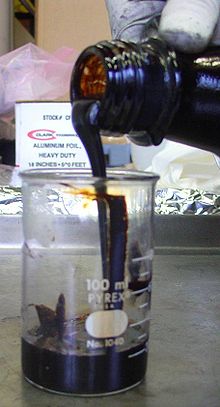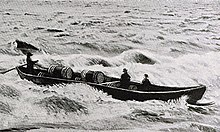Tar

Tar is a dark brown or black viscous liquid of hydrocarbons and free carbon, obtained from a wide variety of organic materials through destructive distillation. Tar can be produced from coal, wood, petroleum, or peat.[1]
Mineral products resembling tar can be produced from fossil hydrocarbons, such as petroleum. Coal tar is produced from coal as a byproduct of coke production.
Terminology
[edit]"Tar" and "pitch" can be used interchangeably. Asphalt (naturally occurring pitch) may also be called either "mineral tar" or "mineral pitch". There is a tendency to use "tar" for more liquid substances and "pitch" for more solid (viscoelastic) substances.[2] Both "tar" and "pitch" are applied to viscous forms of asphalt, such as the asphalt found in naturally occurring tar pits (e.g., the La Brea Tar Pits in Los Angeles). "Rangoon tar", also known as "Burmese oil" or "Burmese naphtha", is also a form of petroleum.[3] Oil sands, found extensively in Alberta, Canada, and composed of asphalt, are colloquially referred to as "tar sands".[4][5]
Wood tar
[edit]
Since prehistoric times wood tar has been used as a water repellent coating for boats, ships, sails, and roofs. In Scandinavia, it was produced as a cash crop. "Peasant Tar" might be named for the district of its production.[6]
Wood tar is still used as an additive in the flavoring of candy, alcohol, and other foods. Wood tar is microbicidal. Producing tar from wood was known in ancient Greece and has probably been used in Scandinavia since the Iron Age. Production and trade in pine-derived tar was a major contributor in the economies of Northern Europe[7] and Colonial America. Its main use was in preserving wooden sailing vessels against rot. For centuries, dating back at least to the 14th century, tar was among Sweden's most important exports. Sweden exported 13,000 barrels of tar in 1615 and 227,000 barrels in the peak year of 1863. The largest user was the Royal Navy of the United Kingdom. Demand for tar declined with the advent of iron and steel ships. Production nearly stopped in the early 20th century. Traditional wooden boats are still sometimes tarred.
The heating (dry distilling) of pine wood causes tar and pitch to drip away from the wood[citation needed] and leave behind charcoal. Birch bark is used to make particularly fine tar, known as "Russian oil", used in Russian leather protection. The by-products of wood tar are turpentine and charcoal. When deciduous tree woods are subjected to destructive distillation, the products are methanol (wood alcohol) and charcoal.
Tar kilns (Swedish: tjärmila, Danish: tjæremile, Norwegian: tjæremile, Finnish: tervahauta) are dry distillation ovens, historically used in Scandinavia for producing tar from wood. They were built close to the forest, from limestone or from more primitive holes in the ground. The bottom is sloped into an outlet hole to allow the tar to pour out. The wood is split into dimensions of a finger, stacked densely, and finally covered tight with earth and moss. If oxygen can enter, the wood might catch fire, and the production would be ruined. On top of this, a fire is stacked and lit. After a few hours, the tar starts to pour out and continues to do so for a few days.
Uses
[edit]
Tar was used as seal for roofing shingles and tar paper and to seal the hulls of ships and boats. For millennia, wood tar was used to waterproof sails and boats, but today, sails made from inherently waterproof synthetic substances have reduced the demand for tar. Wood tar is still used to seal traditional wooden boats and the roofs of historic, shingle-roofed churches, as well as painting exterior walls of log buildings. Tar is also a general disinfectant. Pine tar oil, or wood tar oil, is used for the surface treatment of wooden shingle roofs, boats, buckets, and tubs and in the medicine, soap, and rubber industries. Pine tar has good penetration on the rough wood. An old wood tar oil recipe for the treatment of wood is one-third each genuine wood tar, balsam turpentine, and boiled or raw linseed oil or Chinese tung oil.[citation needed]

In Finland, wood tar was once considered a panacea reputed to heal "even those cut in twain through their midriff". A Finnish proverb states that "if sauna, vodka and tar won't help, the disease is fatal."[8] Wood tar is used in traditional Finnish medicine because of its microbicidal properties.
Wood tar is also available diluted as tar water, which has numerous uses:
- As a flavoring for candies (e.g., Terva Leijona) and alcohol (Terva Viina).
- As a spice for food, like meat.
- As a scent for saunas. Tar water is mixed into water, which is turned into steam in the sauna.
- As an anti-dandruff agent in shampoo.
- As a component of cosmetics.
Mixing tar with linseed oil varnish produces tar paint. Tar paint has a translucent brownish hue and can be used to saturate and tone wood and protect it from weather. Tar paint can also be toned with various pigments, producing translucent colors and preserving the wood texture.
Tar was once used for public humiliation, known as tarring and feathering. By pouring hot wood tar onto somebody's bare skin and waiting for it to cool, they would remain stuck in one position. From there, people would attach feathers to the tar, which would remain stuck on the tarred person for the duration of the punishment. That person would then become a public example for the rest of the day.[9]

Pitch was familiar in 9th-century Iraq, derived from petroleum that became accessible from natural fields in the region. It was sometimes used in the construction of baths or in shipbuilding.[10]
Coal tar
[edit]Coal tar was formerly one of the products of gasworks. Tar made from coal or petroleum is considered toxic and carcinogenic because of its high benzene content,[citation needed] though coal tar in low concentrations is used as a topical medicine for conditions such as psoriasis.[11][12] Coal and petroleum tar has a pungent odor.
Coal tar is listed at number 1999 in the United Nations list of dangerous goods.
See also
[edit]References
[edit]- ^ Daintith, John (2008). "tar". A Dictionary of Chemistry (6th ed.). Oxford University Press. doi:10.1093/acref/9780199204632.001.0001. ISBN 9780199204632. "Tar: Definition". Miriam Webster. Archived from the original on 3 April 2013. Retrieved 14 March 2013. "a dark brown or black bituminous usually odorous viscous liquid obtained by destructive distillation of organic material (such as wood, coal, or peat)". "tar and pitch" (6th ed.). The Columbia Electronic Encyclopedia. Archived from the original on 15 December 2018. Retrieved 14 March 2013. "tar and pitch, viscous, dark-brown to black substances obtained by the destructive distillation of coal, wood, petroleum, peat and certain other organic materials. "
- ^ "tar and pitch" (6th ed.). The Columbia Electronic Encyclopedia. Archived from the original on 15 December 2018. Retrieved 14 March 2013. "The terms tar and pitch are loosely applied to the many varieties of the two substances, sometimes interchangeably. For example, asphalt, which is naturally occurring pitch, is called mineral tar and mineral pitch. Tar is more or less fluid, depending upon its origin and the temperature to which it is exposed. Pitch tends to be more solid."
- ^ De la Rue, Warren; Müller, Hugo (1 August 1856). "Chemical Examination of Burmese Naphtha, or Rangoon Tar". Proceedings of the Royal Society of London. 8: 221–228. Bibcode:1856RSPS....8..221D. JSTOR 111330. Archived from the original on 10 June 2024. Retrieved 10 June 2024.
- ^ "Don't call them 'tar sands' - Macleans.ca". www.macleans.ca.
- ^ Cryderman, Kelly (9 May 2013). "Alberta's oil sands crude: the science behind the debate". The Globe and Mail. Archived from the original on 5 February 2017. Retrieved 14 December 2018.
- ^ "Pine Tar; History and Uses".
- ^ Burger, Pauline. "Ancient maritime pitch and tar a multi-disciplinary study of sources, technology and preservation". British Museum. Archived from the original on 25 November 2018. Retrieved 14 March 2013.
- ^ Sauna, viina ja terva – Potilaan Lääkärilehti Archived 6 March 2022 at the Wayback Machine (in Finnish)
- ^ Burns, Janet (6 August 2015). "A Brief, Sticky History of Tarring and Feathering". Mental Floss. Minute Media. Archived from the original on 12 July 2019. Retrieved 12 July 2019.
- ^ Salim Al-Hassani (2008). "1000 Years of Missing Industrial History". In Emilia Calvo Labarta; Mercè Comes Maymo; Roser Puig Aguilar; Mònica Rius Pinies (eds.). A shared legacy: Islamic science East and West. Edicions Universitat Barcelona. pp. 57–82 [63]. ISBN 978-84-475-3285-8.
- ^ National Psoriasis Foundation (3 December 2001). "The battle to save coal tar in California". www.psoriasis.org. Archived from the original on 29 October 2002. Retrieved 29 June 2023.
- ^ U.S. Food and Drug Administration (1 April 2015). "Drug Products for the Control of Dandruff, Seborrheic Dermatitis, and Psoriasis". www.accessdata.fda.gov. Archived from the original on 18 September 2015. Retrieved 29 June 2023.
External links
[edit]- ^ "Geotimes – February 2005 – Mummy tar in ancient Egypt". Retrieved 9 January 2006.
- Details history and uses of "Rangoon Tar" Archived 4 September 2009 at the Wayback Machine
